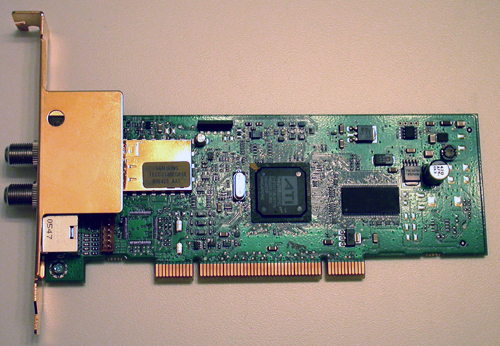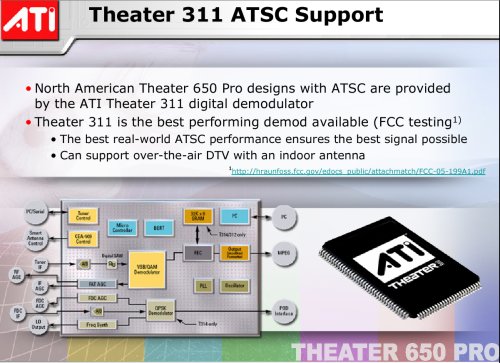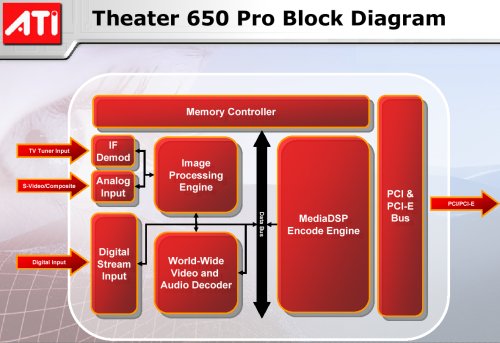The New Theater 650 TV Tuner Solution from ATI
by Josh Venning on June 14, 2006 4:00 AM EST- Posted in
- Smartphones
- Mobile
The Card
The Theater 650 may sport some new features, but the actual card is very similar to the older Theater 550 in size and appearance. The board we have is green in color, which is uncharacteristic of ATI parts (usually their cards are red, or in the A-I-W's case dark purple) but this is likely just because our card is a reference part, and the actual product color will depend on manufacturer preference. Aside from the color, the connections are exactly the same as on the 550, with the Antenna/FM and cable TV inputs, as well as an audio/video input at the bottom.


Being a reference part, our card didn't come with any kind of software bundle, but depending on which manufacturer distributes the card, it will most likely be packaged with the same types of software and accessories that 550 cards come with. Some of the partners who will be distributing the Theater 650 are well known companies like MSI , PowerColor, ASUS, Sapphire and VisionTek.
Architecture
The architecture of the Theater 650 is very similar to the 550, but with a few in changes. The 650 (for NTSC/ATSC countries) includes a Samsung mini-can tuner capable of tuning both analog and digital channels. The "mini-can", from what we understand, is an analog tuner (like the old tin-can tuners that wasted huge amounts of board space) shrunken down to fit in the same area as a silicon tuner. This is a best of both worlds situation where we don't need to worry about the board space of a tin-can, and we shouldn't run into the tuning speed issues we can sometimes see on silicon tuners.
The tuner feeds into both a Theater 311 demodulator and the Theater 650 chips. The Theater 311 digital demodulator supports over-the-air DTV (ATSC) with an indoor antenna. This is an in-house demodulator designed by ATI for their digital TV group, and ATI is very proud of the quality of this part. Testing the Theater 311 and the digital TV capabilities of the Theater 650 are beyond the scope of this article, but we will certainly be looking into these features in the future.

As the tuner feeds into the Theater 650 chip, the signal is internally demodulated and passed into the image processing engine. This is where functions including 3D comb filtering, motion adaptive noise reduction, de-interlacing, and edge enhancement take place. After this step, the cleaned up video flows over to the MediaDSP Encode Engine. Here, ATI is capable of performing the media center requisite MPEG-2 encoding in hardware. In addition to this feature, ATI has included the ability to encode to MPEG-4 (DivX and H.264) and WMV9, through the upcoming Catalyst Media Center software. These are features we are certainly interested in testing when we are able to do so.

We are quite happy to note that with all the additional filtering and feature capabilities ATI has included, they will also be enabling end users to adjust all of these settings at a very low level. Users who know exactly what they want from noise reduction, edge enhancement, and all the other filters will be able to tweak the settings as necessary.
Features
Let's talk a little bit now about the features of the Theater 650. Being the next installment of ATI's Theater series, it will naturally include many of the features of the previous Theater 550 like worldwide audio and NTSC and PAL video standards. However, this time around ATI has added many new features not included in their older cards, or in many competing solutions for that matter.
Firstly, as we mentioned in our introduction, one of the more interesting new features of the Theater 650 is its added digital capabilities. The card is touted by ATI as using next-generation DTV technology which is not yet available in consumer electronics. Basically, the Theater 650 provides digital TV support in ATSC (Advanced Television Systems Committee) for US, Canada, Mexico, and South Korea, as well as DVB-T (Digital Video Broadcasting Terrestrial) for European digital standards. Again, this is one of the first PC tuner cards to incorporate this feature, and certainly the first with the brand recognition of ATI.
ATI has also added some features to the 650 which address image quality, and should provide a better looking video stream. Motion adaptive 3D comb filtering has been included, which will provide sharper video and less false color. Edge enhancement has also been added to improve on image sharpness, and ATI has thankfully given users the option to turn this off, as many users prefer having control over this aspect. Better noise reduction is incorporated as well, and it is now motion compensated for sharper images with less static. Another feature is updated automatic gain and color control, which will provide brighter colors and faster brightness adjustment.
ATI has also designed the Theater 650 to be supported by the new Catalyst Media Center software which will replace ATI's previous Multimedia Center. There will be a new interface and it will provide much more user control over different aspects of video quality (like filters), which is a welcome feature.
All of these features add up to an impressive package which looks to be a significant improvement over the previous Theater cards by ATI. Specifications and buzzwords don't always correlate to a dramatic improvement in real-world applications, however, so we of course need to do some actual testing to see how image quality and CPU utilization on the Theater 650 compares to the Theater 550 and the NVIDIA DualTV MCE.
The Theater 650 may sport some new features, but the actual card is very similar to the older Theater 550 in size and appearance. The board we have is green in color, which is uncharacteristic of ATI parts (usually their cards are red, or in the A-I-W's case dark purple) but this is likely just because our card is a reference part, and the actual product color will depend on manufacturer preference. Aside from the color, the connections are exactly the same as on the 550, with the Antenna/FM and cable TV inputs, as well as an audio/video input at the bottom.


Being a reference part, our card didn't come with any kind of software bundle, but depending on which manufacturer distributes the card, it will most likely be packaged with the same types of software and accessories that 550 cards come with. Some of the partners who will be distributing the Theater 650 are well known companies like MSI , PowerColor, ASUS, Sapphire and VisionTek.
Architecture
The architecture of the Theater 650 is very similar to the 550, but with a few in changes. The 650 (for NTSC/ATSC countries) includes a Samsung mini-can tuner capable of tuning both analog and digital channels. The "mini-can", from what we understand, is an analog tuner (like the old tin-can tuners that wasted huge amounts of board space) shrunken down to fit in the same area as a silicon tuner. This is a best of both worlds situation where we don't need to worry about the board space of a tin-can, and we shouldn't run into the tuning speed issues we can sometimes see on silicon tuners.
The tuner feeds into both a Theater 311 demodulator and the Theater 650 chips. The Theater 311 digital demodulator supports over-the-air DTV (ATSC) with an indoor antenna. This is an in-house demodulator designed by ATI for their digital TV group, and ATI is very proud of the quality of this part. Testing the Theater 311 and the digital TV capabilities of the Theater 650 are beyond the scope of this article, but we will certainly be looking into these features in the future.

As the tuner feeds into the Theater 650 chip, the signal is internally demodulated and passed into the image processing engine. This is where functions including 3D comb filtering, motion adaptive noise reduction, de-interlacing, and edge enhancement take place. After this step, the cleaned up video flows over to the MediaDSP Encode Engine. Here, ATI is capable of performing the media center requisite MPEG-2 encoding in hardware. In addition to this feature, ATI has included the ability to encode to MPEG-4 (DivX and H.264) and WMV9, through the upcoming Catalyst Media Center software. These are features we are certainly interested in testing when we are able to do so.

We are quite happy to note that with all the additional filtering and feature capabilities ATI has included, they will also be enabling end users to adjust all of these settings at a very low level. Users who know exactly what they want from noise reduction, edge enhancement, and all the other filters will be able to tweak the settings as necessary.
Features
Let's talk a little bit now about the features of the Theater 650. Being the next installment of ATI's Theater series, it will naturally include many of the features of the previous Theater 550 like worldwide audio and NTSC and PAL video standards. However, this time around ATI has added many new features not included in their older cards, or in many competing solutions for that matter.
Firstly, as we mentioned in our introduction, one of the more interesting new features of the Theater 650 is its added digital capabilities. The card is touted by ATI as using next-generation DTV technology which is not yet available in consumer electronics. Basically, the Theater 650 provides digital TV support in ATSC (Advanced Television Systems Committee) for US, Canada, Mexico, and South Korea, as well as DVB-T (Digital Video Broadcasting Terrestrial) for European digital standards. Again, this is one of the first PC tuner cards to incorporate this feature, and certainly the first with the brand recognition of ATI.
ATI has also added some features to the 650 which address image quality, and should provide a better looking video stream. Motion adaptive 3D comb filtering has been included, which will provide sharper video and less false color. Edge enhancement has also been added to improve on image sharpness, and ATI has thankfully given users the option to turn this off, as many users prefer having control over this aspect. Better noise reduction is incorporated as well, and it is now motion compensated for sharper images with less static. Another feature is updated automatic gain and color control, which will provide brighter colors and faster brightness adjustment.
ATI has also designed the Theater 650 to be supported by the new Catalyst Media Center software which will replace ATI's previous Multimedia Center. There will be a new interface and it will provide much more user control over different aspects of video quality (like filters), which is a welcome feature.
All of these features add up to an impressive package which looks to be a significant improvement over the previous Theater cards by ATI. Specifications and buzzwords don't always correlate to a dramatic improvement in real-world applications, however, so we of course need to do some actual testing to see how image quality and CPU utilization on the Theater 650 compares to the Theater 550 and the NVIDIA DualTV MCE.










78 Comments
View All Comments
BigLan - Wednesday, June 14, 2006 - link
htpcnews.com and thegreenbutton.com would be two good places to start. There's no card available in the US that can tune a satelite signal directly - they all rely on the set top box connected via s-video. Any of the cards reviewed here, or the Hauppauge PVR series will be able to handle that task.vailr - Wednesday, June 14, 2006 - link
I'm using a TV Wonder Pro, which has much less tuning lag time than the 2 seconds shown for the Theater 650. Maybe: mention alternate choices for those wanting a TV card with less tuning lag time. An exhaustive TV card review would include ALL the various ATI cards, the Hauppauge cards, Avermedia, MSI, nVidia, and several of the high-end HDTV cards, such as the Fusion HDTV. (Some are designed to only work with Windows MCE). There's even a "Linux-only" TV card available. Suggestion: Maybe, partner with Newegg, and do a mini comparison review of every TV tuner card available thru them? And ending with an "Editor's choice" TV card.pjladyfox - Wednesday, June 14, 2006 - link
I'm going to second this idea. A nice TV Tuner card roundup, covering ALL, available cards thru Newegg would be something I'm sure a lot of people would be interested in; possibly even asking for suggestions on questions to focus on for such a roundup.darkfoon - Wednesday, June 14, 2006 - link
Thirding.I have a hauppauge WinTV 250, although I wish I had something that gives me more control over the denoising aspects, or does better denoising (My signal quality is entirely dependant on whether Comcast feels like screwing its standard Basic customers on any given day)
I'd really like an article that compares even cards that I don't know about; cards that could better suit my needs.
pjladyfox - Wednesday, June 14, 2006 - link
I usually look forward to reviews posted on Anandtech due to the depth and detail provided but this one has got to be the worst one I've seen to date. Here's just a sample of questions and details that should have been covered:a. Why was there no mention and/or details given in regards to the DRM hardware that has been mentioned in the press release?
b. Why was this card not paired onto a system using a X1600-series video card to test the AVIVO integration?
c. Why was there no details given about the Catalyst Media Center beyond just it being a footnote?
d. Why was there no details given about other PVR software, such as BeyondTV, support being available?
e. Why was there no details given in regards to capturing from other sources, such as VCR's, from the review?
f. Why was there no details given in regards to the MPEG-4 hardware utilization during the CPU testing?
I mean, Goddess, I could go on and on about just what was missing from this article but I'm sure many more will ask the same question; was this truely a review or just a PR article?
SHSPVR - Wednesday, June 14, 2006 - link
bad news I found out that the 650 dosen't have a hardware trasoncoder it using ref to Soft Avivo Video Converter so there for MPEG4, DivX, WMV9, H.264 it done in REALtime Hardware
SHSPVR - Wednesday, June 14, 2006 - link
Done there not edit post buttonbad news I found out that the 650 dosen't have a hardware trasoncoder it using ref to Soft Avivo Video Converter so there for MPEG4, DivX, WMV9, H.264 it not done in REALtime Hardware
pjladyfox - Wednesday, June 14, 2006 - link
Pardon my language but WTF?! Then how the heck are they able to say that they are Microsoft Vista premium logo ready??Here is a snip from a Dailytech article at http://www.dailytech.com/article.aspx?newsid=2842">http://www.dailytech.com/article.aspx?newsid=2842:
----------------------------
The following are requirements for Windows Vista Premium logo-compliant PC and will be mandated by June 1st, 2007:
* Must have H.264 hardware decoding
* Must have HDCP
* Must support multi-monitor support
* Must have HD audio
* Must have HD audio jack presence detection
* Must have Serial ATA 2.5
* Must have minimum of 50MB NV cache on hybrid HD's with at least 8MB/sec write 16MB/sec read (for mobile only)
* Must support booting from USB flash drives
* Must have Windows Vista Green Button on all remotes
* Must have Green Driver Quality Rating (DQR)
o Green score of 7 to 9
o Yellow score of 4 o 6
o Red score of 1 to 3
----------------------------
I'm really starting to re-considering the Happauge cards at this point. -_-
SHSPVR - Wednesday, June 14, 2006 - link
I guest you didn't read it very well hardware decoding is not the same as hardware encodingLoneWolf15 - Wednesday, June 14, 2006 - link
Mod parent up. He hits every piece of constructive criticism for this article dead on.Good to know about the product, and that Anandtech listens and improves (the nVidia DualTV article was worse) but so much important information was left out of this one.
If the information wasn't available at the time, then Anandtech either should have waited to do the article, or made very clear that this was a very early preview. After owning several ATI TV tuners myself, I know what every ATI xxWonder owner knows --don't buy one until you've heard from others how their Multimedia Center software works, and whether the kinks are worked out. ATI's had a lot of nagging bugs with this software and Anandtech didn't even cover this ground. Add to that the issue of the DRM hardware, quite possibly THE single most important factor in whether Anandtech readers might buy this card or not, and hardly any mention of support under non-MCE Windows versions or third-party products (those that most of us would if we found that Catalyst Media Center sucked) and this article is mostly sizzle, very little steak.